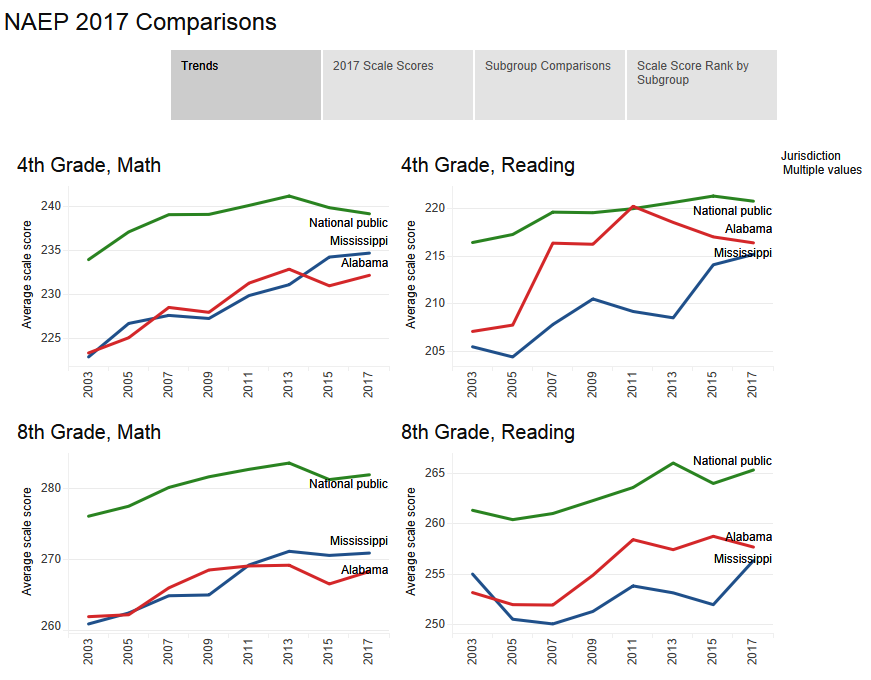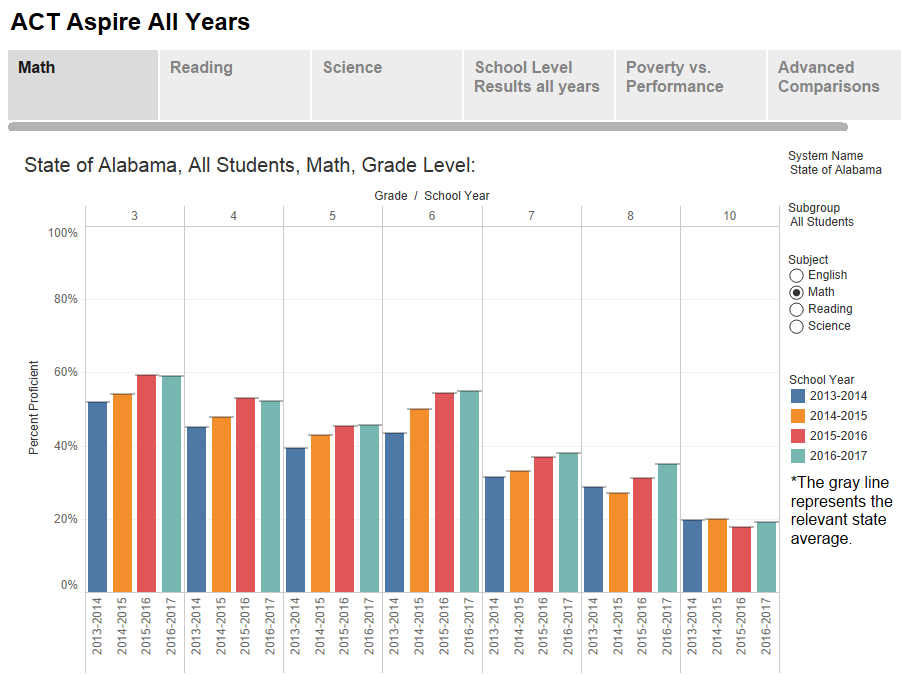
At least in terms of education, it’s time to retire the old Alabama catchphrase, “Thank God for Mississippi.”
It’s an easy response when the latest list comes out that finds Alabama and Mississippi at the bottom of the rankings.
Frequently, Alabama bests Mississippi, and, in so doing, stays out of last place.
However, a review of the latest results on the National Assessment of Education Progress (NAEP) shows Mississippi students now outscore Alabama students on almost every measure.
In 4th and 8th grade math, Mississippi continued its multi-year rise in performance. Comparing all students in each state, Mississippi has a higher average scale score at both grade levels and higher percentages of students scoring proficient.
In reading, Alabama still outscores Mississippi when all students’ scores are averaged together, though the gap between the two states continues to close.
But looking deeper in the data, in every major subgroup measured, Mississippi students are outscoring Alabama students. When comparing Alabama’s white students to Mississippi whites, Alabama black students to Mississippi black students, Alabama Hispanic students to Mississippi Hispanics, Alabama poverty and nonpoverty students with their counterparts in Mississippi, on all those measures, Mississippi comes out on top.
Comparing the different subgroups with their peers in other states provides some assurance for Alabama. Both Alabama and Mississippi tend to show up poorly on “all students” rankings on standardized tests. That is due in part to the fact that historically disadvantaged groups — students from low-income households, blacks, and Hispanics — tend to score lower on standardized tests than whites and students from nonpoverty households. Alabama and Mississippi both have higher percentages of students in poverty and higher minority percentages than most states.
Breaking out the scores by subgroup allows a more nuanced comparison. When comparing subgroups, Alabama’s performance is better in some instances than the overall ranking might suggest. For instance, in 4th-grade math, Alabama’s “all students” rank is fourth from the bottom among U.S. states. However, when directly comparing black students, Alabama black 4th graders outscore black students in 14 other states. A deeper examination of subgroups brings to light some important points.
- It is certainly not the case that Alabama’s lackluster performance on the NAEP can be blamed on black students or poor students. On some measures, blacks and poverty students in Alabama earn a higher national ranking in their respective categories than whites and nonpoverty students. It is weak performance across all subgroups — black and white, poverty and nonpoverty — that weighs on Alabama’s competitive position.
- There is one subgroup that is especially in need of increased attention from Alabama educators: Hispanics. In both grades and both subjects, the average scale score for Alabama Hispanics was lower than the average scale score for Hispanics in any other state.
In the rank table below, you can explore the average scale score of each Alabama subgroup ranking nationally. Bear in mind that the rank for white students, poverty and nonpoverty students includes all 50 states. For Hispanics, there are 47 states in the comparison group, because in three states there weren’t enough Hispanic students tested to generate a statistically valid sample. For black students, the rank is among 40 states on all measures except 4th-grade math. In 4th-grade math, the comparison group includes 42 states.
Looking more broadly,
- Alabama has focused attention on instruction in the early grades and evidence from NAEP shows that has provided benefits. In 2011, Alabama tied the national average in 4th-grade reading. Despite some erosion since then, 4th-grade reading remains stronger than other subjects. In math, Alabama 4th graders improved from No. 50 in 2015 to No. 48 in 2017. Obviously, sustained focus on the early grades remains important.
- However, Alabama’s NAEP results in 8th grade remain consistently poor in both reading and math. Middle grades instruction also deserved concerted focus and investment.
- Alabama should study Mississippi’s approach to see if that state’s progress can provide lessons. While more in-depth analysis is needed, Mississippi education officials credit that state’s progress to continuity of leadership and a sustained, systematic approach to supporting its school districts. The current superintendent, Carey M. Wright, took office in 2013, recruited from the District of Columbia where she was Chief Academic Officer. Mississippi adopted new higher academic standards and set up a system of professional development to help Mississippi teachers teach to the new standards. Mississippi also implemented a literacy initiative similar to the Alabama Reading Initiative but targeted the initiative primarily at high need schools. On the surface, Mississippi’s efforts mirror Alabama’s, a deeper look might reveal ways in which Alabama’s approach can be adjusted in order to produce similar results.


